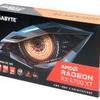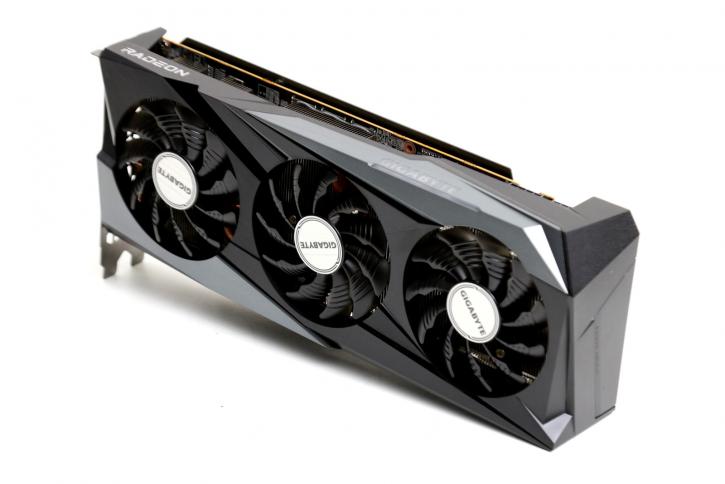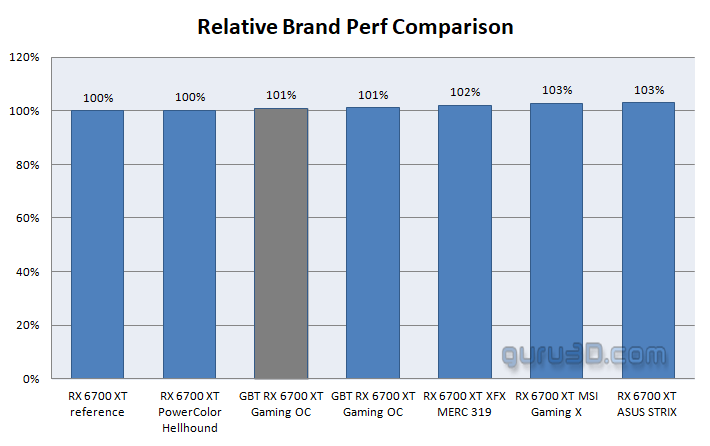Final words and conclusion
Final words
The Gigabyte Gaming OC series with Windforce 3X cooler, as a design has been a classic for years. So again expect little changes to the overall design and looks. However, that works adequately for the. The card perhaps does not have the premium feel that some other brands offer, but it's a design that looks likable and gets the job done whilst the cooling performance is wonderful. The acoustic levels remain very acceptable. Although personally, I feel the silver elements on the cooler would have looked a notch nicer when it would have been an all-dark design. Overall the Radeon RX 6700 XT is a lovely little card in that WQHD (2560x1440) resolution domain for gaming; however expensive. We've seen price hikes in the past two years where mainstream series graphics cards have been repositioned as high-end ones, with accompanying price levels. NVIDIA has started that trend, and where AMD always had a little more value to offer this year, that tide has turned. It might be so that the reference RX 6700 XT sits close to RTX 3060 Ti and sometimes 3070 performance, but only in shading performance. Raw Raytracing performance is a notch slower than the competition offers. We can also not apprehend that AMD still has not implemented any form of machine learning super-sampling dedicated in hardware, much like NVIDIA offers Tensor cores. For these two reasons (RT perf and lacking MLAA), we cast doubt on why AMD is trying to justify that starting price of 479 USD. The true competitor here is the RTX 3060 Ti with its 399 USD MSRP. We want to remind AMD that NVIDIA introduced its Tensor cores back in the summer of 2018, yet still has no to that technology answer implemented. You can also argue that while the Infinity cache works most of the time, it's designed to be a workaround to fill an imperfection in the choice of a more affordable memory type (GDDR6 opposed to GDDR6X), the current AMD GPUs are memory bandwidth deprived, even with GDDR6 at 16 Gbps, but more so due to the 192-bit wide memory bus. And that's going to bite this product in the ass every time you get GPU limited or the L3 cache runs out and gets fewer hits.
So what am I trying to say here? Of course, AMD can opt for a different route in architecture, even with valid reasoning. They still dismiss MLSS/DLSS, the somewhat dim Raytracing performance, and then limited memory bandwidth. It's all fine up to a certain point. Performance overall from the rasterizer/shading point of view in that WQHD domain is absolutely lovely, make no mistake; that starting price of 479 USD for a reference graphics card aimed at the WQHD resolution domain is the biggest obstacle this range will face, especially with current inflated prices in mind.
Performance spread reference and AIBs
The chart below is somewhat arbitrary because results can differ a single % here and there, less so in fillrate limited situation, more so in GPU bound situations. But from reference to the fastest AIB cards, you're looking at 1 to maybe 3% differentials (depending on game and resolution). So you need to weigh in if the additional percental increase is worth an even more steep price premium. So from top to bottom, the differences certainly are not huge, have a peek:
Cooling & acoustic
Gigabyte has a good performing cooling design. Expect 60 up to 65 Degrees C game load ranges depending on the internal airflow inside your chassis. Acoustics wise the product remains silent, reaching the ~37 DBa marker. Gigabyte can be very pleased about that as a result. FLIR imaging shows the card is hardly bleeding heat. Overall, we're very content with what we observed.
Energy consumption
Heat output and energy consumption are closely related to each other, as (graphics) processors and heat can be perceived as a 1:1 state; 250 Watts in energy consumption approaches close to 250 Watts in heat as output. This is the basis of TDP. AMD is listing the card at 230W, which is okay for a graphics card in 2021. We measure the card's entire power consumption (default performance mode) spot on close in at 225 Watt with minor spikes towards 260W. Idle power consumption sits at 16 Watts (TBP - total board power).
Coil whine
Compared to the reference Radeon RX 6700 XT, the card exhibits fewer coil squeal. It's at a level you can hardly hear it. In a closed chassis, that noise would fade away in the background. However, with an open chassis, you can hear coil whine/squeal. Graphics cards all make this in some form, especially at higher framerates; this can be perceived.
Pricing
Worrying. The MSRP for the product as tested is set at 579 USD. That's already a lot of money for a product sitting in the WQHD arena. This gigabyte model currently shows inflated prices by etailers, above the 820 USD/EUR marker.
Tweaking
The Radeon RX 6700 XT series is limited to that 192-bit wide memory bus. It thus likes more memory bandwidth. You can add it by dialing up the memory frequency towards 17.2 Gbps; AMD enforces limits on the memory subsystem, limiting your GDDR6 memory that maximum overclock. We don't like that as we feel we could have gone a notch further. The clock frequency reach is spectacular; after selecting 2900 MHz, the GPU was settling at 2750~2775 MHz; due to the power limiters, you'll have gained an elegant 7% additional performance.
Conclusion
There's little to complain about with the Gaming OC model from Gigabyte; it gets the job done and does that well. At all levels, the performance as can be expected, cooling and heat values look good, as well as acoustics. You could complain a little about the OC models showing so little additional performance compared to the base reference clocked models. It varies per brand and product, but anywhere from 1 to a maximum of 3% is what you're looking at these days, which urges a debate about the relevance of the 'factory OC products' and their price premium. This particular card offers 1% upwards to maybe 2 % additional performance (this varies a bit per game and monitor resolution). Overall the 6700 XT series are very much recommended, aside from the current price levels. You'll retrieve an admirable performing product in that WQHD range at very satisfactory temperatures and acoustic levels. Overall it's an enchanting Full HD and Quad HD graphics card with abilities at Ultra HD as well. Raytracing performance on this generation RDNA2 architecture is mediocre, and of course, AMD could really use something like DLSS. The 12 GB memory is nice. The 192-bit wide memory bus, however narrow. The added L3 cache is bypassing the bulk of that challenge, and that works up to 2560x1440 indeed; however, the L3 cache will always be a bypass, a limitation even as with future more GPU bound games, you're prone to run out of that cache and get a full penalty of that 192-bit wide memory bus. For this willing to shell out such an amount of money for this product range, recommended. But the lowest price we could find was hovering above the 800 USD/EUR mark, and that's a no-go in my book. Of course, that has little to do with Gigabyte, as the product overall is very pleasant.
- Sign up to receive a notification when we publish a new article.
- Or go back to Guru3D's front page.
- Hilbert, LOAD"*",8,1.



